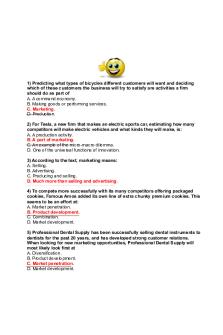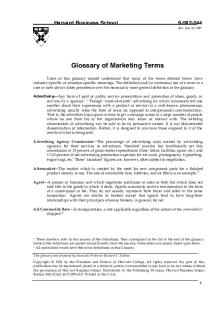MKT 4555 Stukent Midterm PDF

| Title | MKT 4555 Stukent Midterm |
|---|---|
| Author | Linda Li |
| Course | Internet Marketing |
| Institution | Baruch College CUNY |
| Pages | 10 |
| File Size | 401.8 KB |
| File Type | |
| Total Downloads | 17 |
| Total Views | 148 |
Summary
Download MKT 4555 Stukent Midterm PDF
Description
MKT 4555 Stukent CH 1, 2, 4, 5, 6: CH 1: URL vs. Domain Name http://amazon.com Server Cookies Client-side ● HTML ● JavaScript ● CSS
Server-side ● PHP ● Java ● Python ● C++ ● Ruby on Rails Dynamic
Static Transport Layer Security
Primary website objectives: earn money through online sales Other primary website objectives: advertising, commissions, subscriptions, provide info to generate/support offline sales, support a cause, provide customer support Website Type
Primary Conversion
Secondary Conversions
Retail (eCommerce)
Purchase
Create account Sign up for emails Pay for premium account
Lead Generation
Lead (Phone call or form submission)
Sign up for emails
Search Engine
Booking (e.g. hotel reservation)
Click on ad Sign up for emails
Media
Engagement
Page views Video views Create account
Social Media
Create account
Content creation (tweet, post) Content interaction (like, favorite, re-post)
Affiliate Marketing
Click affiliate link
Purchase
Marketplace
Posting item for sale / Making a purchase
Create account
Traffic: ▪ Direct ▪ Unpaid referral ▪ Paid referral ▪ Unpaid search traffic ▪ Paid search traffic
Conversion: ▪ Purchase ▪ Lead ▪ Engagement ▪ Account creation ▪ Click-through Revenue (per conversion)
Direct Traffic: • Recognizable brand • Easy-to-remember URL • Bookmarked pages • Mobile app • Email marketing Paid Referral Traffic: • Banner ads • Text ads • Video ads • Affiliates • Link purchases (not recommended) Unpaid Referral Traffic: • Facebook (>29,000,000 likes!) • Email • Backlinks -Home page -Product pages • Email is generally most cost-effective online marketing channel (i.e., highest ROI) • Social media activity targets established customers/fans • Backlinks – SEO efforts – Interesting content required Search Traffic: • Unpaid search traffic comes by being well-ranked on commonly searched terms • Alternatively, unpaid search traffic comes with good rankings on a lot of less popular search terms • Paid search allows a company to target driven customers • Expense of paid search varies by keyword Conversion: • Most important product information at top (“above the fold”) • Prominent “Add to Cart” button
• Easy-to-navigate checkout procedure • User profile enables stored shipping and credit card information (and email messages) • Conversion is higher with fewer steps in the transaction process Revenue: • Creating a customer is expensive—increasing a customer’s spending is much easier – Add-on product recommendations – Upgrades – Product reviews CH 2: Web Design Frameworks • Design for Usability • Conversion-Centered Design • Three Questions • Segments • Mobile first Design for Usability • Follow website conventions • Create effective visual hierarchies • Break pages up into clearly defined areas • Make it obvious what’s clickable • Eliminate distractions • Format content to support scanning Conversion-Centered Design • Attention • Context • Clarity • Congruence • Credibility • Closing • Continuance 3 Questions: • What are you offering? • Why should I pick you? • What do you want me to do next? Segments: • Conversion, or the next step in the conversion process, should appeal to a variety of customers • Segmentation can have many dimensions – Search versus category navigation – Browse versus directed shopping
– – – –
Product category New versus returning customer Preference for online versus in-store shopping Many more
Mobile First • Design for smaller screens first • Add features and content for larger screens (“Progressive enhancement”) Landing Pages: Single product Multi product Lead generation Subscription Long copy Single purpose Webpage Elements: • Color Scheme • Buttons • Images • Navigation • Trust Symbols • Video • Forms • Phone Numbers CH 4 Search Engine Parts • From Google’s white paper • Indexer-Barrels-Sorter portion is key • PageRank no longer used, but this structure is still relatively accurate
Crawling: • Find new and updated web content – URL Server tracks pages – Crawler explores all links to find new pages • URL Server must prioritize crawling – Crawlers are fast, but with limits – Frequently updated content will be crawled more often – Can be problematic Caching: • TML code of webpage sent to repository – Google has cached copy of entire world wide web – Cache = temporary storage Indexing: • Recodes each web page as a “hit list” – A “hit” is a word occurrence (not to be confused with a web hit, when someone views a web page) – Each page indexed as a series of words
Storing Hit Lists: • Partially sorts hits – docID sent to barrel corresponding to wordID – Some duplication of docID’s – Prepares docID’s for re-sorting by wordID Sorting: • Hit lists sorted by docID are not searchable – Must sort by wordID – Search engine results must find all docIDs that use the searched-for word Analyzing links: • Links used for multiple purposes – Crawling – Creating list of webpages (docIDs) – Calculating relevance – Calculating PageRank • No longer used • Many link metrics still used Searching on Google: • Searcher types “metamorphosis” into Google – All docIDs containing wordID 21548 found – Relevance score for each docID calculated – PageRank of each webpage (docID) found – Relevance and PageRank combined to determine final rankings Multi Word Searches • Butterfly metamorphosis – “butterfly” – “metamorphosis” – “butterfly metamorphosis” • Much easier to earn good rankings for multiple-word searches Keyword Usage: • URL • Title Tag • Header Tags • Main Content • Alt Text • Anchor Text Choosing Keywords: • Relevance • Traffic • Competition
• Current ranking Google Evolution: • PageRank • Panda • Penguin • Pigeon • Hummingbird • Knowledge Graph • RankBrain • Mobile-First The 5 Components of SEO Size Time Popularity Linking Text Load Time: • Overstock pages are data intensive – Could cause slow loading – Technically up to date Fresh Content: • New products available • Sales and promotions • Articles • Reviews • Q&A CH 5 No Follow Links: “Don’t follow links on this page” Untrusted content Paid links Low priority links Popularity Metrics: • Number of backlinks • Backlinks from related/relevant websites • Anchor text • Link neighborhood • Link freshness • Link diversity • Social sharing
Content Marketing: Appealing content -Entertaining -Useful Distribution -SEO -Social sharing -Paid Conversion
CH 6:
Ad Copy: • Keyword relevance • Enticing and unique value proposition (UVP) • Obvious call to action (CTA) • Ad extensions
Capturing Lost Conversions: Non-converters: - Did not like what they saw - Were not likely to convert anyway - Were not ready to convert (but may be ready in the future) Campaign Settings: • Campaign Type – Search network only
– Display network only – Search network with display select – Shopping • Device – Desktop – Tablet – Mobile • Ad extensions – Location – Affiliate location – Callout – Call – Message – Sitelink – Structured snippet • Available headers: Amenities, Brands, Courses, Degree programs, Destinations, Featured hotels, Insurance coverage, Models, Neighborhoods, Service catalog, Shows, Styles, Types – Price – Review – App...
Similar Free PDFs

MKT 4555 Stukent Midterm
- 10 Pages

MKT 310 Midterm Review
- 10 Pages

MKT 421solution
- 12 Pages

TP 2 MKT 2 90% - Tp2 MKT
- 10 Pages

TP 3 MKT 2 80% - Tp3 MKT
- 10 Pages

MKT 421solution
- 10 Pages

MKT 421solution
- 10 Pages

MKT Glossary
- 24 Pages

Colun mkt
- 17 Pages

MKT 370 SWOT Analysis
- 2 Pages

Koko krunch mkt 460
- 71 Pages

Bike Simulation Report (mkt
- 10 Pages

Resumen MKT OK
- 18 Pages

Chifa SAM SEN MKT
- 6 Pages
Popular Institutions
- Tinajero National High School - Annex
- Politeknik Caltex Riau
- Yokohama City University
- SGT University
- University of Al-Qadisiyah
- Divine Word College of Vigan
- Techniek College Rotterdam
- Universidade de Santiago
- Universiti Teknologi MARA Cawangan Johor Kampus Pasir Gudang
- Poltekkes Kemenkes Yogyakarta
- Baguio City National High School
- Colegio san marcos
- preparatoria uno
- Centro de Bachillerato Tecnológico Industrial y de Servicios No. 107
- Dalian Maritime University
- Quang Trung Secondary School
- Colegio Tecnológico en Informática
- Corporación Regional de Educación Superior
- Grupo CEDVA
- Dar Al Uloom University
- Centro de Estudios Preuniversitarios de la Universidad Nacional de Ingeniería
- 上智大学
- Aakash International School, Nuna Majara
- San Felipe Neri Catholic School
- Kang Chiao International School - New Taipei City
- Misamis Occidental National High School
- Institución Educativa Escuela Normal Juan Ladrilleros
- Kolehiyo ng Pantukan
- Batanes State College
- Instituto Continental
- Sekolah Menengah Kejuruan Kesehatan Kaltara (Tarakan)
- Colegio de La Inmaculada Concepcion - Cebu

